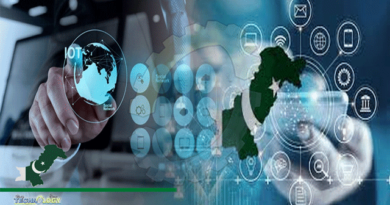Digital technology is reshaping the world rapidly. It is transforming everything from the way of governments and citizens interact and how markets behave and consumers pay bills. It is boosting industrial and cultural productivity and revolutionizing health and education. Every economy is endeavouring for digital transformation.
Pakistan also wants to tap its potential in this. Some sceptics cast clouds of pessimism, but recent developments and governmental initiatives indicate Pakistan’s readiness for greater digitalization. For example introduction of e-courts, giving the expatriate Pakistanis the e-vote and the desire of Pakistani youth to go digital. However, like all other revolutions, the digital can also go topsy turvy if not taken wisely. Therefore, Pakistan should pay extra heed to making digitalization work. Pakistan should develop its digital infrastructure, and disseminate information and awareness among the masses.
Since 2013 Pakistan started to pay extra attention to the process of digitization. It was also reflected in the election manifestoes of almost all the political parties. The first digitization policy surfaced in 2013. Its aim was to kickstart the debate about technological change; therefore, its scope remained limited. It laid the foundation for Pakistan’s efforts to bring the economy at par with developed economies. Initially, it was limited to engagement with stakeholders and creating jobs for IT experts.
The slogan “Roti, Kapra, Makan Aur Internet” stands prominent in Pakistan’s efforts to materialize its dreams of digitization. It not only underscores the strength and scope of digitization, but also gives a roadmap to bring the dream of digitization to fruition. Digital agenda 2020 stood on six pillars: enhancing connectivity, improving digital skills, and promoting innovation and entrepreneurship. The agenda also involved spreading awareness about digital Pakistan. The PM also met freelancers and youtubers.
Some sceptics cast clouds of pessimism, and questioned Pakistan’s readiness for digital change. They believe Pakistan is caught by complex and multifaceted problems; and therefore is not ready to benefit from digitization. True, Pakistan is encountering enormous problems but the desire of Pakistan’s youth to swim the tide of digitization, and entrepreneurs and freelancer,s are factors that invalidate this stance.
Digitization can be a panacea for all ills. It can help Pakistan improve agricultural productivity by introducing digital means of agriculture. It can create jobs. Moreover, it can revolutionize the health and education sectors of Pakistan via video, and make it possible to ensure online access to far flung areas. It can help government check ghost teachers.
The World Economic Forum sees Pakistan as the dark horse in the digitization race . Ebay’s chief executive said Pakistan has emerged from the war on terror, and is now on a decent path of progress. This improved investors’ confidence.Digitization will provide inclusive financial services in a transparent, safe, low cost, and efficient way to the largely unbanked and underbanked population.
Moreover, in 2018 Chinese largest e-commerce market brought Pakistan’s Daraz.pk. and companies like Uber and Careem also made inroads to Pakistan. The advent of Uber, Careem, Food Panda, and Daraz.pk is a ray of hope to accelerate the process of digitization. It will not only improve Pakistan’s declining economy, but also improve lifestyles.
The government’s vision for a digital Pakistan is extensive and encompasses infrastructure, e-governance, fintech and digital skills; to ensure its success multiple mobile applications, and reforms have been introduced. Digitization will no doubt cure the existing ills of Pakistan. However, challenges threatening its success must be addressed on war footing and reforms in digital literacy, data protection laws, and consumer protection laws must be brought to ensure the success of digitization of Pakistan.
Not only has the usage of internet by state and society increased manifold, but also the state started to make digitization take root. In November 2018 Pakistan Post launched an online complaint centre and e-governance web portal. Similarly, Pakistan Railways, Pakistan Post, FBR and PIA also launched mobile and online applications. Thus Pakistan is getting ready for digital change.
The digital power of China’s BRI is unfolding a new era of opportunity. It creates the biggest possibility from CPEC. Pakistan China Optical FiberCable creates the land-based link between Pakistan and China. The 820-km fiberoptic cable is expected to extend to Gawada.
Besides this, in 2019 Pakistan also introduced E-courts. It will strengthen Pakistan’s judicial system, ensuring speedy and cheap justice. It is a step towards digitization.
Many other reforms are also underway in bringing about meaningful changes on digital lines to the electoral process.
Besides, Information Technology industry has also progressed. It became one of the top five export industries with the highest net export in the services industries, with reported inflow for July 2018-January 2019 of $114.4 million.
Pakistan has the advantage a young population, 60 percent. Educated youth has already shown keen interest in digitization, as many young educated students have used digital means of communication for their benefit, accepting careers as freelancers.
Internet expansion enabled online banking as the SBP issued branchless banking regulations in 2008, making Pakistan the first country in south Asia to allow branchless banking. In 2019, 27 banks are offering internet Banking Service, with 3.1 million internet users registered, while during January-March 2019, 8.6 million transactions worth Rs 862.3 billion were processed.
Similarly, digitization has unleashed enormous opportunities for women. According to womenintech.pk, digitization has created 45 percent jobs for young women. Moreover, owing to social stigmatization women could not go outside for jobs, but many women work from home online as freelancers or content writers.
In much of Pakistani society, women are easy targets of violence. Digitization gave a voice to women. Many cases of violence against women drew the attention of the authorities. For example the rape and murder case of Zainab in Qusoor generated an unprecedentedawareness on social media. That incident also generated the Zainab Alert Bill. The KP assembly passed MeraBacha Alert and launched a phone app.
There are challenges to be taken into account to make digitization work. Digital illiteracy is one. Digitization without digital illiteracy or digital skills is meaningless.
Likewise, the digital infrastructure is also substandard, creating unnecessary hurdles in digitalization. The Telecom sector, owing to flexible policy, invited massive foreign direct investment. Owing to inflexible policy not only foreign direct investment declined but also internet subscriptions fell. The strict policy needs evisiting.
Owing to the lack of cyber laws, cyber bullying is rampant. It is not only creating challenges for Pakistan but also discouraging women and depriving them of the right to work freely. It must be taken seriously. Like lack of cyber laws, lack of date protection law is also a challenge. This emboldens the abusers and gives rise to cyber theft and privacy breach.
In Pakistan there are very few information technology universities. Thus, Pakistan could not keep pace with the dynamics of digitization. Research is also not being done on technological subjects. Lack of research, and of a skilled workforce, is a stumbling block. Therefore, Pakistan should pay extra attention to it.
To meet its dreams of digitization, Pakistan should locate more funds for information technology. It should create more and more universities, to promote research and scholarship in technology. It should also encourage cultural exchange programmes with developed countries and seek help and guidance in order to digitize Pakistan.
There is a wide gap in rural and urban areas in internet access. Pakistan should take serious action to mitigate this gap. It should ensure uninterrupted access throughout Pakistan. It will help Pakistan to bring about meaningful changes in its digital landscape, and also improve its international standing.
Singapore’s success in digitalization remains central to its rise as a great economy of Asia. Singapore developed its digital infrastructure on four key elements: developing digital talent, encouraging research and innovation, facilitating digital-friendly regulations, building infrastructure and enabling unhindered connectivity. Pakistan should seek help and guidance from Singapore to digitize Pakistan meaningfully.
Another Asian nation that successfully transformed their economy on the digital front is Malaysia from smart city projects to traffic control systems, energy management to smart factories, its success speaks for itself. Pakistan should learn lessons and replicate the reforms introduced by Malaysia.
It has been observed that recently, people have been defrauded by online companies. Therefore, Pakistan should implement strictly the consumer protection laws. It will boost the confidence of the public on online shopping outlets, and will encourage e-business and e-marketing.
The government’s vision for a digital Pakistan is extensive and encompasses infrastructure, e-governance, fintech and digital skills; to ensure its success multiple mobile applications, and reforms have been introduced. Digitization will no doubt cure the existing ills of Pakistan. However, challenges threatening its success must be addressed on war footing and reforms in digital literacy, data protection laws, and consumer protection laws must be brought to ensure the success of digitization of Pakistan.






















